By Steve Temple, automedia.com
Difficulty: Easy
Estimated time: 180 minutes
Taking one look at the cracked and splitting car seat, we figured the upholstery was beyond repair. That probably meant an expensive re-covering job, which didn’t seem likely, given the age and value of the vehicle. Not happy about the costly alternatives, we decided to give it a try ourselves. The results were well worth the effort, as this repair cost only $150 to $200, much less than a new leather upholstery job. Here’s how we succeeded in fixing the torn car seat, and how you can do the same.
Prep
First, do your best to clean up the old upholstery. On leather seats,
usually the flat panels on the bottom and back are made of genuine animal
hides, and the sides are color-matched vinyl, because of its better
flexibility. We discovered that some of the apparent dirt in the grain was
actually cracked and damaged leather, which would require a re-dye or color
coat (which we might attempt at a later date).
Prior to proceeding with repairs, a thorough cleaning is necessary to remove other types of chemicals that might have been applied to the surface. Because water and oil don’t mix, silicone-based or petroleum treatments are the enemy.
Application
Once the material is thoroughly cleaned and scrubbed, the first stage of
the repair involves applying thin layers of a repair compound with a
palette knife between the torn edges of the vinyl, directly onto the white
backing material. The edges are not actually joined together, as in
stitching together a torn piece of fabric. Instead the repair acts as a
filler/patch. After a brief warming from a heat gun to cure the patch,
apply a piece of flexible material with a grain imprint that imparts a
matching texture to the smooth surface of the patch.
Once that dries, clean the surface yet again, and apply a vinyl-prepping compound to ensure the color will adhere properly. To verify, do a "tape test" (using a piece of masking tape) to make sure the surface is sufficiently tacky and will accept the dye.
Color spray
Spraying on the color topcoat proved to be the trickiest part, since beige
upholstery is usually the hardest to match. Experiment with a few different
combinations of tints from bottles of dye to try to get the exact hue. It
helps to blend the colors together.
This type of repair, which can be done on a variety of soft and hard plastics, along with leather upholstery, is more than just a stitch in time. With a bit of color sense and artistry, your repair can look as good as new.
The process
Follow these steps to repair the torn upholstery.

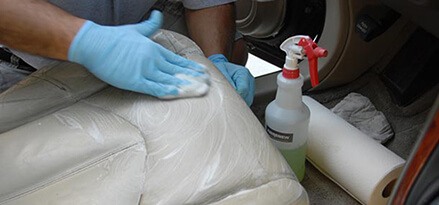
Step 2: Before repair – Any previously applied treatments, especially silicone-based, must be cleaned off thoroughly with a scrubbing pad and a foaming solution.
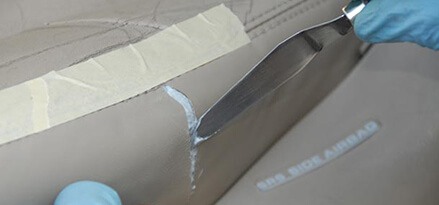
Step 3: Begin patching – After masking off the area to be repaired with tape, the patching material is applied in several thin layers with a palette knife to the exposed white backing material.
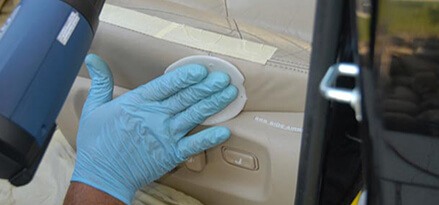
Step 4: Cure then add material – After using a heat gun to cure the repair, press a piece of flexible material with a grainy surface onto the repair area to match the texture of the surrounding vinyl. A few different types of texture are available, from satin-smooth to a pebbly grain.

Step 5: Drying – The patch dries quickly, and creates a strong, seamless bond that’s ready for a color topcoat.

Step 6: Fill and sand – A filler/adhesive is used in the damaged areas of the seam, which is then sanded down smooth to the same level as the rest of the stitched area.
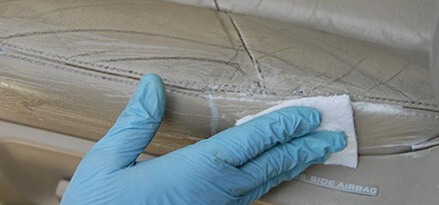
Step 7: More prep – Additional cleaner and vinyl prep are then applied so the color coats will adhere.
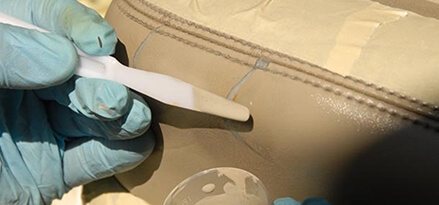
Step 8: Matching the color – Various combinations of color tints are mixed into the cup of a spray gun. Matching the color precisely will be the biggest challenge, particularly for beige.

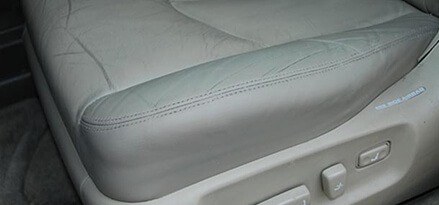
Step 10: Final step – With the exception of re-dyeing the vinyl, the repair is done and the job complete.

